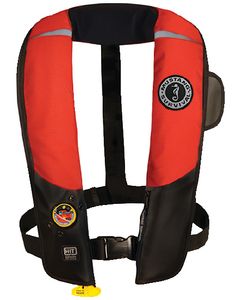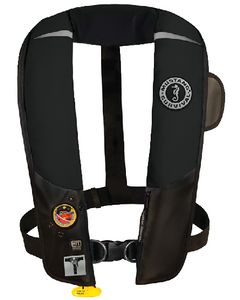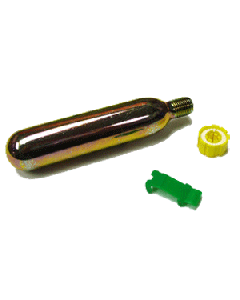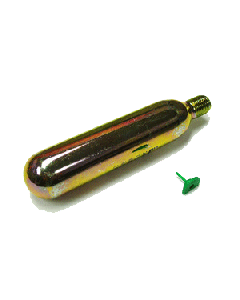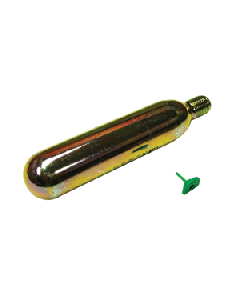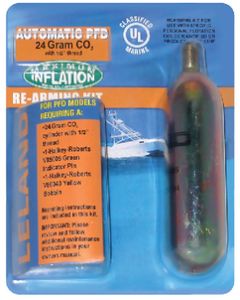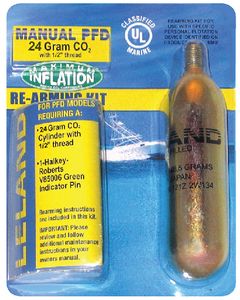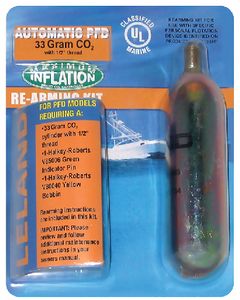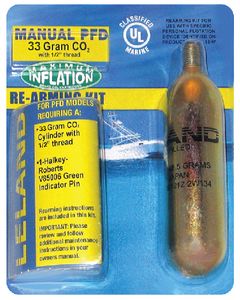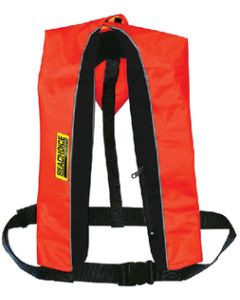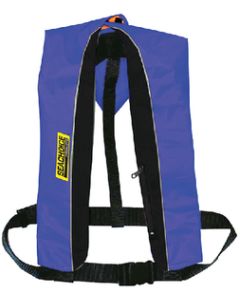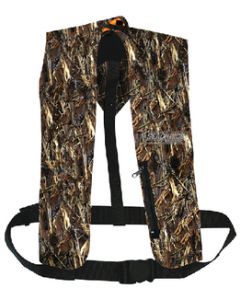Inflatable Life Vests
Life Jackets and Personal Flotation Devices (PFDs)
Life jackets or PFDs can mean the difference between life and death out on the water. PFDs are a very important lifesaving device that you have to carry on your boat. All the life jackets or PFDs that you buy must meet Coast Guard approval. Always check for USCG approval on label before purchasing. Be sure to check with your state to be in compliance with state laws in addition to federal requirements.
Take into consideration that the PFDs must be the appropriate size for the intended user. Life jackets or PFDs must be immediately available for use. It is essential that you try your jacket before you need it. You should learn how to put it on, make sure it fits and if it's an inflatable type, it should be tested out. Be sure to check inflatables for green "armed" indicator.
It is important to make sure that everyone puts on a life jacket before leaving the dock. People can fall overboard unexpectedly or be washed over by waves, and wearing a life jacket is crucial for safety. On large craft and cruise ships where life jackets are not required at all times, people should still make sure they know where their life jackets or PFDs are and how to use them. People should adjust their life jackets or PFDs as soon as they put them on to position them firmly on the body. Good fit is critical for proper life saving performance. It is essential to frequently check to see that the beacon and transponder are operational. Straps tend to weather and fray as a result of being exposed to water and sunlight and should be checked for signs of hard wear. If the straps appear to be damaged, they or the life jacket should be replaced for safety. There are life jackets which simply acquire buoyancy by the inflation of nylon or vinyl chambers. These can be inflated by exhalation or by the pulling of a cord. Some respond to water pressure by self-inflating. These are usually the type stowed aboard ships, boats and aircraft.
The most common life jackets have traditional permanent flotation and modern jackets use foam flotation. These jackets are rugged, reliable and the best option for prolonged time in water. They are available in a huge range of designs, but overall the foam makes them more bulky than inflatable jackets.
Hybrid jackets combine the benefits of inflatable with a bit of permanent flotation included.
There are a number of life jacket designs of PFDs available for various applications: Type I PFDs (The offshore jacket design): Provides maximum buoyancy and turns an unconscious victim face up in the water. These PFDs are available in adult and child sizes. Child size must provide a minimum of 11 lbs. of buoyant lift, adult size a 22lb minimum (33lb inflatable). They are the best for all waters, open ocean, rough seas, or remote water, where rescue may be slow coming. High buoyancy keeps head clear of rough water. The ones that have foam style are bulky for everyday functionality.
Type II PFDs (Coastal life jacket): They are for near shore use and they will turn unconscious victims face up in the water, but not as pronounced as Type I righting force. Adult size provides a minimum of 15.5 lbs. of positive flotation (33lb inflatable), medium children size 11 lbs. of buoyant lift, and small children size 7 lbs. lift. They are Good for general boating activities in calm, inland waters, or where there is a good chance for fast rescue.
Type III PFDs (Comfort over safety): They are designed to complement boating activities. They are restricted to near shore activities where chance of rescue is much quicker. Does not turn unconscious person face up and the wearer may have to lean back to prevent being face down in the water. They are used for general boating or the specialized activity that is marked on the device such as water skiing, hunting, fishing, canoeing, kayaking and others. They are good for calm, inland waters, or where there is a good chance for fast rescue. This category includes float coats and vests that insulate against cold water hypothermia.
Type IV PFDs (Throwables): Throwable devices such as cushions, horse shoe and life ring buoys. Type IV PFDs no longer fulfill the personal PFD requirement for vessels under 16ft.
Type V PFDs (Special Design): These are PFDs for specific water activities for example hybrid inflatable PFDs, canoe/kayak vest, boardsailing vests, deck suits, work vests for commercial vessels, commercial whitewater vests man-overboard rescue devices, law enforcement flotation devices.
Life jackets or PFDs can mean the difference between life and death out on the water. PFDs are a very important lifesaving device that you have to carry on your boat. All the life jackets or PFDs that you buy must meet Coast Guard approval. Always check for USCG approval on label before purchasing. Be sure to check with your state to be in compliance with state laws in addition to federal requirements.
Take into consideration that the PFDs must be the appropriate size for the intended user. Life jackets or PFDs must be immediately available for use. It is essential that you try your jacket before you need it. You should learn how to put it on, make sure it fits and if it's an inflatable type, it should be tested out. Be sure to check inflatables for green "armed" indicator.
It is important to make sure that everyone puts on a life jacket before leaving the dock. People can fall overboard unexpectedly or be washed over by waves, and wearing a life jacket is crucial for safety. On large craft and cruise ships where life jackets are not required at all times, people should still make sure they know where their life jackets or PFDs are and how to use them. People should adjust their life jackets or PFDs as soon as they put them on to position them firmly on the body. Good fit is critical for proper life saving performance. It is essential to frequently check to see that the beacon and transponder are operational. Straps tend to weather and fray as a result of being exposed to water and sunlight and should be checked for signs of hard wear. If the straps appear to be damaged, they or the life jacket should be replaced for safety. There are life jackets which simply acquire buoyancy by the inflation of nylon or vinyl chambers. These can be inflated by exhalation or by the pulling of a cord. Some respond to water pressure by self-inflating. These are usually the type stowed aboard ships, boats and aircraft.
The most common life jackets have traditional permanent flotation and modern jackets use foam flotation. These jackets are rugged, reliable and the best option for prolonged time in water. They are available in a huge range of designs, but overall the foam makes them more bulky than inflatable jackets.
Hybrid jackets combine the benefits of inflatable with a bit of permanent flotation included.
There are a number of life jacket designs of PFDs available for various applications: Type I PFDs (The offshore jacket design): Provides maximum buoyancy and turns an unconscious victim face up in the water. These PFDs are available in adult and child sizes. Child size must provide a minimum of 11 lbs. of buoyant lift, adult size a 22lb minimum (33lb inflatable). They are the best for all waters, open ocean, rough seas, or remote water, where rescue may be slow coming. High buoyancy keeps head clear of rough water. The ones that have foam style are bulky for everyday functionality.
Type II PFDs (Coastal life jacket): They are for near shore use and they will turn unconscious victims face up in the water, but not as pronounced as Type I righting force. Adult size provides a minimum of 15.5 lbs. of positive flotation (33lb inflatable), medium children size 11 lbs. of buoyant lift, and small children size 7 lbs. lift. They are Good for general boating activities in calm, inland waters, or where there is a good chance for fast rescue.
Type III PFDs (Comfort over safety): They are designed to complement boating activities. They are restricted to near shore activities where chance of rescue is much quicker. Does not turn unconscious person face up and the wearer may have to lean back to prevent being face down in the water. They are used for general boating or the specialized activity that is marked on the device such as water skiing, hunting, fishing, canoeing, kayaking and others. They are good for calm, inland waters, or where there is a good chance for fast rescue. This category includes float coats and vests that insulate against cold water hypothermia.
Type IV PFDs (Throwables): Throwable devices such as cushions, horse shoe and life ring buoys. Type IV PFDs no longer fulfill the personal PFD requirement for vessels under 16ft.
Type V PFDs (Special Design): These are PFDs for specific water activities for example hybrid inflatable PFDs, canoe/kayak vest, boardsailing vests, deck suits, work vests for commercial vessels, commercial whitewater vests man-overboard rescue devices, law enforcement flotation devices.

